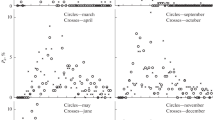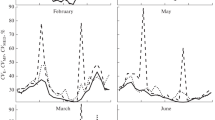Abstract
The work examines diurnal variations in the statistical characteristics of the variability of the electron number density NmF2 of the maximum of the ionspheric F2 layer during quiet geomagnetic conditions at low solar activity based on hourly ionosonde measurements of the critical frequency of the ionspheric F2 layer from 1957 to 2017 over Moscow. The statistical parameters of NmF2 are calculated for each month M of each year at the universal time UT = 0, 1, … 23 h: the mathematical expectation NmF2E; the most probable value NmF2MP; the average monthly median NmF2MED; the arithmetic mean NmF2A; the standard deviations of NmF2 from NmF2E, NmF2MP, and NmF2MED; and the coefficients of variation CVE, CVMP, and CVMED of NmF2 relative to NmF2E, NmF2MP, and NmF2MED, respectively. It follows from the calculations that the CVE, CVMED, and CVMP values vary within the intervals of 12–43%, 12–60%, and 13–75%, respectively, and, in the vast majority of cases, CVE(UT, M) < CVMED(UT, M) and CVE(UT, M) < CVMP(UT, M). If the coefficient CVE in each month of each year is compared for different time points, the lowest CVE value varies from 12% (July) to 19% (December) and occurs during daytime, while the highest CVE value lies in the interval from 26% (June) to 43% (December). For each UT, the lowest and highest values of this coefficient in the autumn, winter, and spring months are greater than those for the summer months. It was found that the difference of NmF2A(UT, M) from NmF2E(UT, M) does not exceed 0.2%.






Similar content being viewed by others
REFERENCES
Araujo-Pradere, E.A., Fuller-Rowell, T.J., and Bilitza, D., Ionospheric variability for quiet and perturbed conditions, Adv. Space Res., 2004, vol. 34, no. 9, pp. 1914–1921.https://doi.org/10.1016/j.asr.2004.06.007
Araujo-Pradere, E.A., Fuller-Rowell, T.J., and Codrescu, M.V., Characteristics of the ionospheric variability as a function of season, latitude, local time, and geomagnetic activity, Radio Sci., 2005, vol. 40, no. 5, p. RS5009.https://doi.org/10.1029/2004RS003179
Bilitza, D., Altadill, D., Zhang, Y., Mertens, C., Truhlik, V., Richards, P., and Reinisch, B., The international reference ionosphere 2012: A model of international collaboration, J. Space Weather Space Clim., 2014, vol. 4, no. A07, pp. 1–12. https://doi.org/10.1051/swsc/2014004
Forbes, J.M., Palo, S.E., and Zhang, X., Variability of the ionosphere, J. Atmos. Sol.-Terr. Phys., 2000, vol. 62, no. 8, pp. 685–693.https://doi.org/10.1016/S1364-6826(00)00029-8
Gatti, P.L., Probability Theory and Mathematical Statistics for Engineers, London: Spon Press, 2005.
Hedin, A.E., MSIS-86 thermospheric model, J. Geophys. Res., 1987, vol. 92, no. 5, pp. 4649–4662. https://doi.org/10.1029/JA092iA05p04649
Kremer, N.Sh., Teoriya veroyatnostei i matematicheskaya statistika (Probability Theory and Mathematical Statistics), Moscow: YuNITI-DANA, 2012.
Liu, H.-L. and Richmond, A.D., Attribution of ionospheric vertical plasma drift perturbations to large-scale waves and the dependence on solar activity, J. Geophys. Res., 2013, vol. 118, no. 9, pp. 2452–2465.https://doi.org/10.1002/jgra.50265
Pavlov, A.V., The low and middle latitude semi-annual anomaly in NmF2 near noon: A statistical study, Adv. Space Res., 2012, vol. 49, no. 5, pp. 922–936. https://doi.org/10.1016/j.asr.2011.12.024
Pavlov, A.V., Causes of the mid-latitudinal daytime NmF2 semi-annual anomaly at solar minimum, J. Atmos. Sol.-Terr. Phys., 2018, vol. 169, pp. 6–15. https://doi.org/10.1016/j.jastp.2017.12.015
Pavlov, A.V. and Pavlova, N.M., Effect of solar radiation refraction on the zenith angle and times of the sunrise and sunset in the atmosphere, Geomagn. Aeron. (Engl. Transl.), 2010, vol. 50, no. 2, pp. 219–224.
Pavlov, A.V. and Pavlova, N.M., Variations in statistical parameters of the NmF2 winter anomaly with latitude and solar activity, Geomagn. Aeron. (Engl. Transl.), 2012, vol. 52, no. 3, pp. 335–343.
Pavlov, A.V. and Pavlova, N.M., Variations in statistical parameters of the NmF2 equinoctial asymmetry with latitude and solar activity near noon, Adv. Space Res., 2013, vol. 51, no. 11, pp. 2018–2034. https://doi.org/10.1016/j.asr.2013.01.007
Pavlov, A.V. and Pavlova, N.M., Influence of the equinoctial asymmetry on the semi-annual anomaly in NmF2 near noon in the northern geographic hemisphere: A statistical study, Adv. Space Res., 2014, vol. 53, no. 4, pp. 619–634. https://doi.org/10.1016/j.asr.2013.12.014
Pavlov, A.V. and Pavlova, N.M., Dependences of the NmF2 midlatitude statistical characteristics on the month of a year under geomagnetically quiet conditions near noon at low solar activity, Geomagn. Aeron. (Engl. Transl.), 2015, vol. 55, no. 4, pp. 487–492. https://doi.org/10.7868/S0016794015040112
Pavlov, A.V. and Pavlova, N.M., Long-term monthly statistics of mid-latitudinal NmF2 in the northern geographic hemisphere during geomagnetically quiet and steadily low solar activity conditions, J. Atmos. Sol.-Terr. Phys., 2016, vol. 142, pp. 83–97. https://doi.org/10.1016/j.jastp.2016.03.001
Pavlov, A.V., Pavlova, N.M., and Makarenko, S.F., A statistical study of the mid-latitude nmF2 winter anomaly, Adv. Space Res., 2010, vol. 45, no. 3, pp. 374–385. https://doi.org/10.1016/j.asr.2009.09.003
Picone, J.M., Hedin, A.E., Drob, D.P., and Aikin, A.C., NRLMSISE-00 empirical model of the atmosphere: Statistical comparisons and scientific issues, J. Geophys. Res., 2002, vol. 107, no. 12, pp. SIA 15-1–SIA 15-16. https://doi.org/10.1029/2002JA009430
Piggott, W.R. and Rawer, K., U.R.S.I. Handbook of Ionogram Interpretation and Reduction, Asheville, N.C.: National Oceanic and Atmospheric Administration, 1972; Moscow: Nauka, 1978.
Richards, P.G., Fennelly, J.A., and Torr, D.G., EUVAC: A solar EUV flux model for aeronomical calculations, J. Geophys. Res., 1994, vol. 99, no. 5, pp. 8981–8986. https://doi.org/10.1029/94JA00518
Richmond, A.D. and Lu, G., Upper-atmospheric effects of magnetic storms: A brief tutorial, J. Atmos. Sol.-Terr. Phys., 2000, vol. 62, no. 12, pp. 1115–1127. https://doi.org/10.1016/S1364-6826(00)00094-8
Rishbeth, H. and Mendillo, M., Patterns of F2-layer variability, J. Atmos. Sol.-Terr. Phys., 2001, vol. 63, no. 15, pp. 1661–1680. https://doi.org/10.1016/S1364-6826(01)00036-0
Ross, S.M., Introduction to Probability and Statistics for Engineers and Scientists, Amsterdam: Elsevier, 2004.
Schunk, R.W. and Nagy, A.F., Ionospheres. Physics, Plasma Physics, and Chemistry, Cambridge: Cambridge University Press, 2009.
Author information
Authors and Affiliations
Corresponding author
Additional information
Translated by M. Chubarova
Rights and permissions
About this article
Cite this article
Pavlov, A.V., Pavlova, N.M. Diurnal Variations in the Statistical Characteristics of the Variability of the Midlatitude NmF2 during Quiet Geomagnetic Conditions at Low Solar Activity. Geomagn. Aeron. 59, 593–605 (2019). https://doi.org/10.1134/S0016793219040133
Received:
Revised:
Accepted:
Published:
Issue Date:
DOI: https://doi.org/10.1134/S0016793219040133




